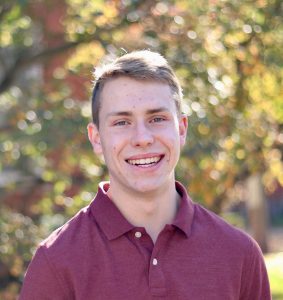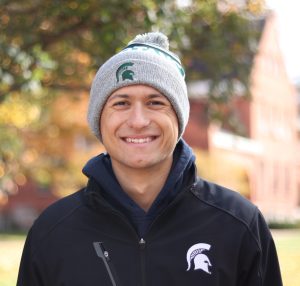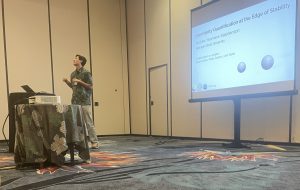By Sloane Barlow
They say education can really take you places.
For Honors College students Landon Buskirk and Andrew Yeomans-Stephenson, it took them all the way to Hawaii for the joint meeting of the American Physical Society Division of Nuclear Physics and the Physical Society of Japan.
The organizing committee selected Buskirk and Yeomans-Stephenson to present at the five-day event, based on papers the students submitted.
Developing Data Tools as a Second-Year Student

Landon Buskirk is a second-year student studying data science with a minor in physics, exploring his interest in applying data science methods to natural science research. The project he presented at the conference was Streamlining Nuclear Physics Data and Uncertainty Quantification with the Bayesian Mass Explorer.
“My research has been focused on developing tools, specifically an interactive web app called BMEX – Bayesian Mass Explorer,” Buskirk said. “This website – this tool – is meant to have a suite of different web apps for nuclear theorists and nuclear experimentalists to really have data visualization tools and data retrieval tools at their disposal.”
“This tool is meant to bring together different data sets of models and different experiments and kind of put it all in one spot, so that people can have it at their fingertips online,” Buskirk said.

Buskirk first started his research at Michigan State as a professorial assistant to Dr. Witold Nazarewicz, Chief Scientist of the Facility for Rare Isotope Beams (FRIB) at MSU. Buskirk works with a group under Nazarewicz that focuses broadly on developing models to predict nuclear structure, nuclear masses, and different types of atoms that are being studied at FRIB.
At the conference in Hawaii, Buskirk presented to experts in his field for the first time. He said it added pressure, but provided exciting opportunities to receive trusted feedback, make connections, and spark collaboration.
Research Mentors and the Edge of Stability

Yeomans-Stephenson is a second-year physics student and a Wielenga Research Scholar. The research project he presented at the conference was Uncertainty Quantification at the Edge of Stability.
“My research focuses on TDDFT – Time-Dependent Density Functional Theory,” Yeomans-Stephenson said. “It’s more like the uncertainty quantification of it, so I’m working with nuclei and we’re trying to figure out the stability of the nuclei and the characteristics of it over time.”
“We’re mainly focusing on oxygen-24 and calcium-40 and calcium-48,” Yeomans-Stephenson said. “Many times in the code we’re running it has been with stable nuclei, however with oxygen-24 it is quite exotic.”

He first began his research in the summer internship program Research Experience for Undergraduates with the College of Natural Sciences. At the beginning of the program, he was paired with Kyle Godbey, a research assistant at FRIB, and Pablo Giuliani, a research associate in the Department of Statistics and Probability. Both continued as Yeomans-Stephenson’s mentors throughout the program.
Yeomans-Stephenson said he was excited to present in Hawaii. “I have much joy in teaching people other things,” he said, “especially something I’m so passionate about, something I worked with for so long. It’s something that is very special to me.”
He said the conference provided an opportunity to learn more about the diversity of physics roles at the professional level.
